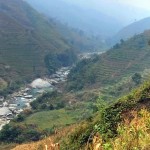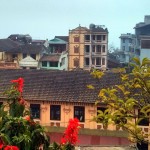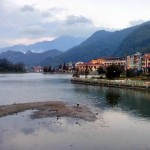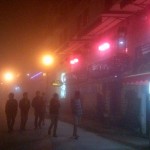This section from Hekou to Sa Pa is the tenth instalment of my bicycle ride from Yunnan to Cambodia – if all goes according to plan. Titled “Slap the Belgian!”, it is simultaneously published on Crazyguyonabike.com, where you’ll find a map with the itinerary and many other bicycle diaries by me and others. I hope you’ll enjoy.
Day 11: Transferring to Vietnam
I’d submitted my passport to the Hekou visa office at 9 am, hoping that it’d be ready in a few hours. Unfortunately, I learn that I can pick up my visa by 6.30 pm. It seems the best thing to do is get into the visa office before 4 pm on any weekday. That way you can be across the border by 7 pm the same day. Price is 450 RMB if you’re handsome, and 500 RMB otherwise – according to the giggling girls running the business. Bah. Another day at Hekou, it’s starting to get on my nerves.
I spend the day slowly – Yunnan style – walking around town, ignoring attempts by pompous Chinese trying to make conversation in abominable English. The hours tick away slowly. A visit to the Hekou uprising museum and trying to decode the text kills a few of them. The museum is actually quite interesting if you can read what it says (no English, although the titles are in Pinyin, as if that helps anyone). There are quite a few interesting pictures and maps from middle nineteenth to the early twentieth century, including the building of the railroad by the French and portraits with biographies of the revolutionaries.

A few tedious hours later, I run into Hu, a guy I run into several times every time I stay at Hekou. He’s a nice and laid-back local construction worker, always shirtless with a leather jacked draped around his shoulders. “Bilish” he calls me, more or less the word for Belgium. He’s about 1m55 tall and spends his undoubtedly low wage on Vietnamese hookers (always inviting me along) and cocaine from Thailand and Myanmar. A nose worth goes for only 20 kuai he says, best price anywhere. He offers me some from a candy box, but I refuse.
The day concludes with more conversation. This time with a self-important investment guide who manages to talk down a 700 RMB bracelet to 20 and then doesn’t buy, and with a Kunming-based fruit merchant from Sichuan. He says he can get me cheap avocados so I take his number. Then the visa office woman finally shows up on the bridge, waving my passport at me. Vietnam, here I come!
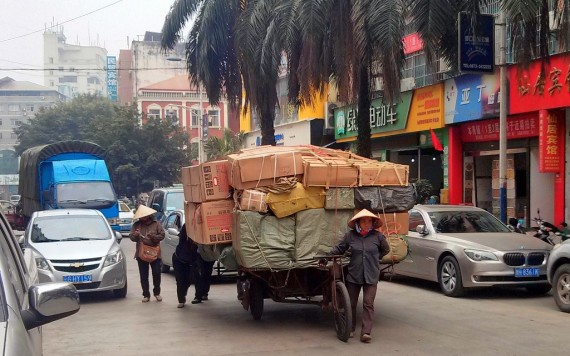
Rolling my bike through the gate is a matter of minutes. The Chinese officials are very correct and so are the Vietnamese – I guess, because I would find it arrogant to use Chinese with them so I don’t understand what they say. Check, look in the camera, question, stamp stamp, question, look in the camera, stamp stamp, do you want to change money, no, stamp, bye. Off I ride, into the Lao Cai night. I know very well I don’t need to change money anywhere: my credit card will work just fine in Vietnam and so should my Chinese bank card.
Riding around in Vietnam is exhilarating. Everything moves just a little bit faster, it’s all a little more chaotic and there are more distracting attractions on the side: coffee houses, draft beer cafés, noodle shops, big shiny neon ads – all in a language I don’t understand at all. I’m lapping it up.

As I pull out some cash of the ATM, I suddenly hear English behind me. That’s the first real English in 11 days! Behind me are two Australian women on their way from Sa Pa to Ha Noi. A bit further I spot some more foreigners, and then more and more. It feels strange and I’m starting to get worried about the price of the hotel I’ll sleep at. Hopefully I don’t have to check twenty rooms before finding a reasonably priced one.
I don’t. The hotel finds me. A woman waves me into a place called The Nest, shows me the room and tells me it’s 200,000 VND (€ 8). I look around and can’t believe my eyes. It’s not a particularly large room, but it’s very clean, no dust behind the door or stains on the walls and there’s WiFi and a hot shower, what else do I want? Outside, a couple of foreigners sip on cold Hanoi Beers (at 20,000 VND, they’re a bit steep), toying with their phones. Not a chance of conversation. Backpacking is dead. The iPhone killed it. I buy a SIM card next door so I can join the hollow legion.
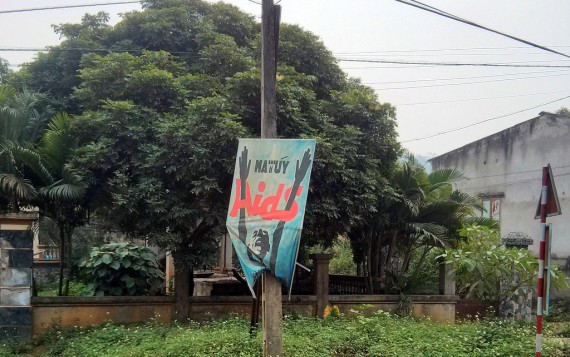
Before going to bed I try to buy a can of beer to enjoy with a movie, but everyone seems to be bent on ripping me off so I resort to drinking the leftover bottle of Yanjing I have in my drybags. A funny parallel with my first day in China, which I also spent sipping Hanoi beer I’d smuggled in.
Day 12: Ride to Sa Pa
I didn’t sleep that well. Loud trucks were thundering down the road bringing goods from China to Hanoi all night and I had forgotten to switch on the air-con. I take a shower, pack and get the hell out of the train station area. Today’s ride is going to Sa Pa, a holiday mountain resort at 1500 m above sea level. Before I begin the 1400 m climb, I stock up on a delicious Banh mi with pâté (10,000 VND talked down from 20) and water mixed with lemon juice.
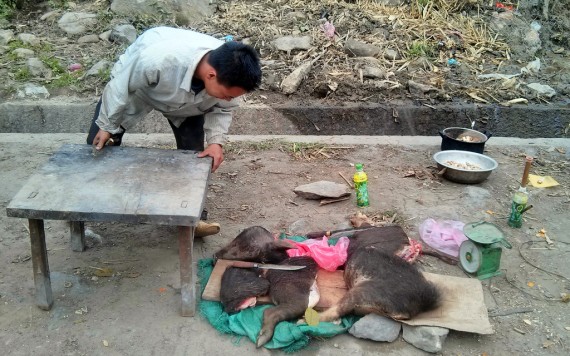
I read somewhere that there are no towns between Lao Cai and Sapa and no places to get food or sleep. So for another 10,000 VND I buy a bunch of plantains from some elderly Hmong ladies hanging out by the side of the road. Again a bit too much, but when you’re talking cents there’s no real reason to complain. The alarm was false. Although I didn’t see a place to stay the night, there are plenty of places that sell noodles, bananas and drinks on the way and there’s even a real restaurant.
I’ve again developed some more inner and outer knee pain, so I take a stretching break and toy with my bicycle’s adjustment. The seat a little higher but more to the front seems to help. The pain not only disappears but I’m also able to climb faster. All this time I’ve been suffering for nothing! I curse myself for not doing this 12 days earlier. The slope is gradual and I make quick progress. It gives me the time to ponder the differences between Vietnam and China.

First category is hygiene. Chinese hotels may all look fine in the lobby, and maybe even inside the rooms, but then you move a piece of furniture or look in a hard-to-reach spot. All kinds of stuff is crawling around, dust and spent condoms are piling up. In the bathroom you’ll find hidden used toothbrushes and pieces of soap. Mind, I know that a lot of rural Vietnamese guesthouses have the same problem.
Second is greeting. Although interaction with both people is very friendly, Vietnamese generally greet in a more restrained manner. Chinese will stare the living soul out of you and shout ha-lou until you’re out of sight. Vietnamese, on the other hand, do a way more natural-sounding hello that does not sound like they’ve suffered brain damage, and all other greetings are limited to a civilised nod, a raised hand or a victory sign.

Third in the charts is conversation. Whenever I can understand them, Vietnamese usually just hold a short, interested conversation. Chinese that speak English always seem to be trying hard to impress and look better than the others around them. A very unsympathetic trait. Fourth is simple gesture communication. When you want anything done in China, you had better speak Chinese. Not so in Vietnam:
When I bought my SIM card in Lao Cai yesterday, I thought it would take forever. But it was easy. I walk into a phone shop, show my Chinese card and the man points at three operator logos behind him. I choose Viettel and he tosses a card on the counter. I need a micro-SIM for my phone, so I use my thumb and index to indicate that I want it smaller. He instantly grabs a card cutter. Then he grabs a calculator and enters the amount I have to pay – I’m back before my beer got warm. In China, the same procedure would take half an hour, three forms, a passport check, the summoning of colleagues to giggle at the foreigner, a phone call to a manager and a Mexican wave of goodbyes by the entire staff as you walk out. Very charming, but Vietnam wins at efficiency.

With all this thinking going on, I find myself approaching Sapa before I’m well aware of it. The 37 km simply flew by. I heard it was high season for Sapa so I was again worried about the hotel prices. A hotel I’d called wanted $45 for a night and that’s way more than I want to pay. Luckily again, the hotel found me, in the form of a lady riding her scooter behind me. At 140,000 VND for a clean room with WiFi, I think I’ve struck a great deal.
Sapa’s pretty, but suffers from that same ailment that many Chinese tourist hotspots have: overaccommodation. The principle is simple: tourists come, so everyone turns his property into a restaurant or a hotel. The result is a fairly dead town and tons of eateries with in each just a few people. For a solitary traveller, this is a nightmare. Luckily, the Belgian flag on my bicycle attracts a Belgian couple from Brussels. We spend the afternoon chatting at ‘Le Gecko’, where I have a nice burger (first Western meal in two weeks), a milkshake, ice coffee and a hot chocolate. Another difference with China is that Western food in Vietnam can actually be pretty great! I begin to realise how Spartan travelling in China can be.

When fog and night jointly creep into Sapa town, I go on a mission to buy a road atlas of Vietnam. I find one, and once again the price is carefully scratched off and replaced by a sticker with a much higher price. I tell him I know the real price and offer him 40,000 extra for carrying it up here. In return I get some good advice about the roads ahead. I have dinner with a Frenchman and return to my quarters to sleep off the hills.






